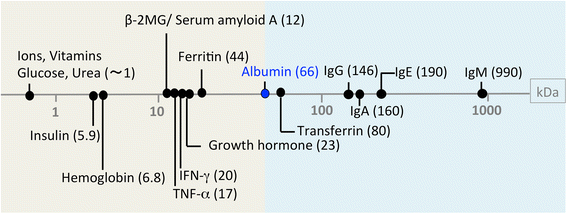Regulation of blood vascular permeability in the skin
- PMID: 29259710
- PMCID: PMC5725833
- DOI: 10.1186/s41232-017-0042-9
Regulation of blood vascular permeability in the skin
Abstract
Regulation of blood vessel permeability is essential for the homeostasis of peripheral tissues. This regulation controls the trafficking of plasma contents, including water, vitamins, ions, hormones, cytokines, amyloids, lipoproteins, carrier proteins, and immunoglobulins. The properties of blood vessels vary among tissues based on their structural differences: continuous, fenestrated, or sinusoidal. These three types of blood vessels have different charge and size barrier properties. The anionic luminal glycocalyx layer on endothelial cells establishes the "charge barrier" that repels the attachment of negatively charged blood cells and plasma molecules. In contrast, the "size barrier" of blood vessels largely relies on the interendothelial junctions (IEJs) between endothelial cells, which define the paracellular permeability. As in most peripheral tissues, blood capillaries in the skin are composed of continuous and/or fenestrated blood vessels that have relatively tighter IEJs compared to those in the internal organs. Small vesicles in the capillary endothelium were discovered in the 1950s, and studies have since confirmed that blood endothelial cells transport the plasma contents by endocytosis and subsequent transcytosis and exocytosis-this process is called transcellular permeability. The permeability of blood vessels is highly variable as a result of intrinsic and extrinsic factors. It is significantly elevated upon tissue inflammations as a result of disabled IEJs and increased paracellular permeability due to inflammatory mediators. An increase in transcellular permeability during inflammation has also been postulated. Here, we provide an overview of the general properties of vascular permeability based on our recent observations of murine skin inflammation models, and we discuss its physiological significance in peripheral homeostasis.
Keywords: Blood vessel; Immunoglobulin; Inflammation; Interendothelial junctions; Paracellular; Permeability; Skin; Transcellular.
Figures


Similar articles
-
Role of caveolin-1 in the regulation of pulmonary endothelial permeability.Methods Mol Biol. 2011;763:303-17. doi: 10.1007/978-1-61779-191-8_21. Methods Mol Biol. 2011. PMID: 21874461
-
Regulation of endothelial permeability via paracellular and transcellular transport pathways.Annu Rev Physiol. 2010;72:463-93. doi: 10.1146/annurev-physiol-021909-135833. Annu Rev Physiol. 2010. PMID: 20148685 Review.
-
Physiologic upper limits of pore size of different blood capillary types and another perspective on the dual pore theory of microvascular permeability.J Angiogenes Res. 2010 Aug 11;2:14. doi: 10.1186/2040-2384-2-14. J Angiogenes Res. 2010. PMID: 20701757 Free PMC article.
-
Normal endothelium.Handb Exp Pharmacol. 2006;(176 Pt 1):1-40. doi: 10.1007/3-540-32967-6_1. Handb Exp Pharmacol. 2006. PMID: 16999215 Review.
-
Signaling mechanisms regulating endothelial permeability.Physiol Rev. 2006 Jan;86(1):279-367. doi: 10.1152/physrev.00012.2005. Physiol Rev. 2006. PMID: 16371600 Review.
Cited by
-
The omega-3 postbiotic trans-10-cis-15-octadecadienoic acid attenuates contact hypersensitivity in mice through downregulation of vascular endothelial growth factor A.Front Cell Infect Microbiol. 2024 May 22;14:1355679. doi: 10.3389/fcimb.2024.1355679. eCollection 2024. Front Cell Infect Microbiol. 2024. PMID: 38841110 Free PMC article.
-
On the Role of Platelet-Generated Amyloid Beta Peptides in Certain Amyloidosis Health Complications.Front Immunol. 2020 Oct 2;11:571083. doi: 10.3389/fimmu.2020.571083. eCollection 2020. Front Immunol. 2020. PMID: 33123145 Free PMC article. Review.
-
Afferent Lymphatic Transport and Peripheral Tissue Immunity.J Immunol. 2021 Jan 15;206(2):264-272. doi: 10.4049/jimmunol.2001060. J Immunol. 2021. PMID: 33397740 Free PMC article. Review.
-
In vivo imaging of type 1 diabetes immunopathology using eye-transplanted islets in NOD mice.Diabetologia. 2019 Jul;62(7):1237-1250. doi: 10.1007/s00125-019-4879-0. Epub 2019 May 14. Diabetologia. 2019. PMID: 31087105 Free PMC article.
-
DIA proteomics identified the potential targets associated with angiogenesis in the mammary glands of dairy cows with hemorrhagic mastitis.Front Vet Sci. 2022 Aug 8;9:980963. doi: 10.3389/fvets.2022.980963. eCollection 2022. Front Vet Sci. 2022. PMID: 36003411 Free PMC article.
References
-
- Qiao RL, Wang HS, Yan W, Odekon LE, Del Vecchio PJ, Smith TJ, et al. Extracellular matrix hyaluronan is a determinant of the endothelial barrier. Am J Physiol. 1995;269:C103–109. - PubMed
Publication types
LinkOut - more resources
Full Text Sources
Other Literature Sources
Research Materials

